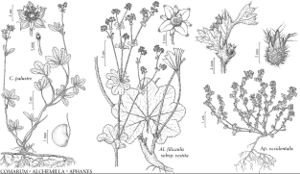Comarum
Sp. Pl. 1: 502. 1753.
Gen. Pl. ed. 5, 220. 1754.
| Taxon | Illustrator ⠉ | |
|---|---|---|
 | Comarum palustre Alchemilla filicaulis subsp. vestita Aphanes occidentalis | Marjorie C. Leggitt Marjorie C. Leggitt Marjorie C. Leggitt |
Herbs, perennial, 1–6 dm; stoloniferous and rhizomatous. Stems 1–several, decumbent to ascending aerial stems arising from horizontal ground-level stems, horizontal stems often rooting at nodes, sometimes floating, aerial stems glabrous proximally, finely appressed-hairy and often purplish-glandular distally. Leaves usually marcescent, cauline, alternate, odd-pinnate to subpalmate; stipules marcescent, partially to completely adnate to base of petiole, linear-lanceolate to elliptic-ovate, usually entire, sometimes serrate apically; petiole present, marcescent; blade ± cordate in outline, 2–15 cm, foliaceous, leaflets (3–) 5–7, lanceolate or oblanceolate to elliptic or obovate, margins flat, crenate to deeply serrate throughout or apically, venation pinnate, surfaces glabrous or finely appressed hairy. Inflorescences terminal, 1–10-flowered, flowers solitary or loosely cymose, hairy and often purplish-glandular; bracts present, leafy, smaller distally; bracteoles absent. Pedicels present, straight or nearly so. Flowers 1–3 cm diam.; epicalyx bractlets 5; hypanthium slightly cupulate, 1–2 × (3–) 4–8 mm, villous; sepals 5, spreading to reflexed, broadly ovate; petals 5, deep red to purple, rarely pink, ovate to spatulate, shorter than sepals; stamens (15–) 20–25 (–30), shorter than or equal to petals, filaments filiform, not flattened, glabrous, thecae solitary, horseshoe-shaped, rimming broad connective, dehiscing by continuous, narrow, marginal slit; torus hemispheric; carpels 30–100, glabrous, styles lateral to subbasal, filiform; ovule 1. Fruits aggregated achenes, individually deciduous (sometimes tardily so), 30–100, obliquely ovoid, (1–) 1.3–1.6 mm, glabrous; torus enlarged, spongy, not fleshy, hairy; hypanthium persistent; sepals persistent, reflexed; styles persistent, jointed. x = 14.
Distribution
North America, Eurasia
Discussion
Species 1.
In North America, Comarum differs from Potentilla by its strikingly deep red to purple petals that are shorter than the sepals and its generally sprawling habit with rooting nodes in distinctly wet habitats. The dark reddish or purplish color generally infuses other floral parts (calyces, anthers, styles). Petals in Potentilla sect. Rubrae (Rydberg) O. Stevens are similarly colored but more or less obcordate and longer than the sepals, and the plants are otherwise typical of that genus in habit, habitat, and palmate leaves.
The fruiting structure of Comarum is intermediate between that of Fragaria and those of most other Potentilleae. As in Fragaria, the torus becomes enlarged and spongy (but not fleshy) in fruit, albeit completely covered by ultimately deciduous achenes. As supported by molecular data (T. Eriksson et al. 1998, 2003), Comarum is more closely related to Fragaria than to Potentilla in the strict sense. It will hybridize with members of Fragaria (J. R. Ellis 1962), giving rise to commercially available pink-flowered strawberries.
This treatment follows J. Soják (2008) in treating Comarum as monospecific; the other species sometimes placed in this genus is Farinopsis salesoviana (Stephan) Chrtek & Soják.
Selected References
None.
Lower Taxa
"thin" is not a number.